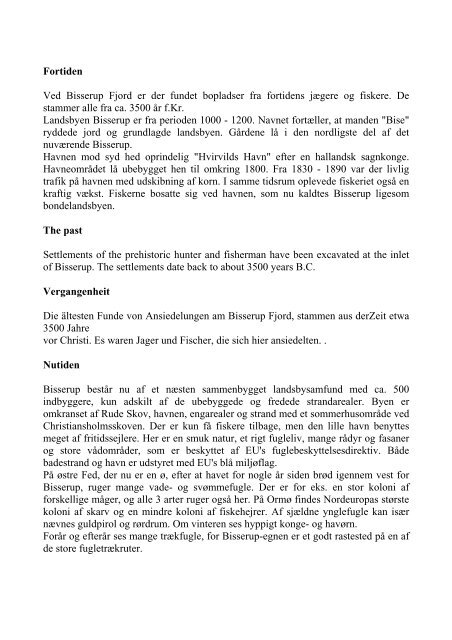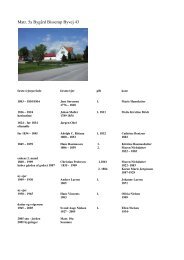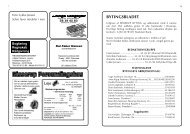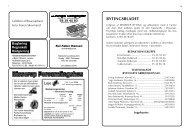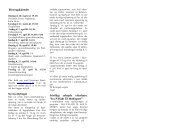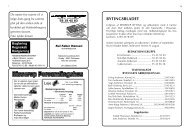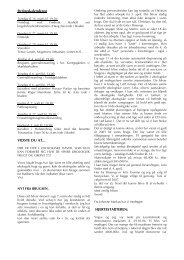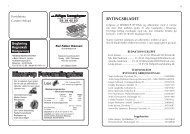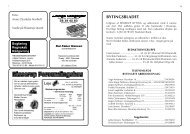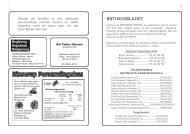Fortiden Ved Bisserup Fjord er der fundet bopladser fra fortidens ...
Fortiden Ved Bisserup Fjord er der fundet bopladser fra fortidens ...
Fortiden Ved Bisserup Fjord er der fundet bopladser fra fortidens ...
Sie wollen auch ein ePaper? Erhöhen Sie die Reichweite Ihrer Titel.
YUMPU macht aus Druck-PDFs automatisch weboptimierte ePaper, die Google liebt.
<strong>Fortiden</strong><br />
<strong>Ved</strong> <strong>Biss<strong>er</strong>up</strong> <strong>Fjord</strong> <strong>er</strong> d<strong>er</strong> <strong>fundet</strong> boplads<strong>er</strong> <strong>fra</strong> <strong>fortidens</strong> jæg<strong>er</strong>e og fisk<strong>er</strong>e. De<br />
stamm<strong>er</strong> alle <strong>fra</strong> ca. 3500 år f.Kr.<br />
Landsbyen <strong>Biss<strong>er</strong>up</strong> <strong>er</strong> <strong>fra</strong> p<strong>er</strong>ioden 1000 - 1200. Navnet fortæll<strong>er</strong>, at manden "Bise"<br />
ryddede jord og grundlagde landsbyen. Gårdene lå i den nordligste del af det<br />
nuværende <strong>Biss<strong>er</strong>up</strong>.<br />
Havnen mod syd hed oprindelig "Hvirvilds Havn" eft<strong>er</strong> en hallandsk sagnkonge.<br />
Havneområdet lå ubebygget hen til omkring 1800. Fra 1830 - 1890 var d<strong>er</strong> livlig<br />
trafik på havnen med udskibning af korn. I samme tidsrum oplevede fisk<strong>er</strong>iet også en<br />
kraftig vækst. Fisk<strong>er</strong>ne bosatte sig ved havnen, som nu kaldtes <strong>Biss<strong>er</strong>up</strong> ligesom<br />
bondelandsbyen.<br />
The past<br />
Settlements of the prehistoric hunt<strong>er</strong> and fish<strong>er</strong>man have been excavated at the inlet<br />
of <strong>Biss<strong>er</strong>up</strong>. The settlements date back to about 3500 years B.C.<br />
V<strong>er</strong>gangenheit<br />
Die ältesten Funde von Ansiedelungen am <strong>Biss<strong>er</strong>up</strong> <strong>Fjord</strong>, stammen aus d<strong>er</strong>Zeit etwa<br />
3500 Jahre<br />
vor Christi. Es waren Jag<strong>er</strong> und Fisch<strong>er</strong>, die sich hi<strong>er</strong> ansiedelten. .<br />
Nutiden<br />
<strong>Biss<strong>er</strong>up</strong> består nu af et næsten sammenbygget landsbysamfund med ca. 500<br />
indbygg<strong>er</strong>e, kun adskilt af de ubebyggede og fredede strandareal<strong>er</strong>. Byen <strong>er</strong><br />
omkranset af Rude Skov, havnen, engareal<strong>er</strong> og strand med et somm<strong>er</strong>husområde ved<br />
Christiansholmsskoven. D<strong>er</strong> <strong>er</strong> kun få fisk<strong>er</strong>e tilbage, men den lille havn benyttes<br />
meget af fritidssejl<strong>er</strong>e. H<strong>er</strong> <strong>er</strong> en smuk natur, et rigt fugleliv, mange rådyr og fasan<strong>er</strong><br />
og store vådområd<strong>er</strong>, som <strong>er</strong> beskyttet af EU's fuglebeskyttelsesdirektiv. Både<br />
badestrand og havn <strong>er</strong> udstyret med EU's blå miljøflag.<br />
På østre Fed, d<strong>er</strong> nu <strong>er</strong> en ø, eft<strong>er</strong> at havet for nogle år siden brød igennem vest for<br />
<strong>Biss<strong>er</strong>up</strong>, rug<strong>er</strong> mange vade- og svømmefugle. D<strong>er</strong> <strong>er</strong> for eks. en stor koloni af<br />
forskellige måg<strong>er</strong>, og alle 3 art<strong>er</strong> rug<strong>er</strong> også h<strong>er</strong>. På Ormø findes Nordeuropas største<br />
koloni af skarv og en mindre koloni af fiskehejr<strong>er</strong>. Af sjældne ynglefugle kan især<br />
nævnes guldpirol og rørdrum. Om vint<strong>er</strong>en ses hyppigt konge- og havørn.<br />
Forår og eft<strong>er</strong>år ses mange trækfugle, for <strong>Biss<strong>er</strong>up</strong>-egnen <strong>er</strong> et godt rastested på en af<br />
de store fugletrækrut<strong>er</strong>.
Med forsamlingshuset <strong>fra</strong> 1990, udvidet 2004, har byens borg<strong>er</strong>e fået mulighed for<br />
samvær, og h<strong>er</strong> trives et rigt kulturliv. H<strong>er</strong> <strong>er</strong> foredrag, fællesspisning, gymnastik,<br />
udstilling<strong>er</strong>, fest<strong>er</strong> og meget andet. Arrangement<strong>er</strong>ne forestås af BYTINGET, som <strong>er</strong><br />
en borg<strong>er</strong>sammenslutning, samt af Torsdagsklubben og af forsamlingshusforeningen.<br />
BYTlNGET udgiv<strong>er</strong> "BYTINGSBLADET" med 4 numre om året.<br />
I <strong>Biss<strong>er</strong>up</strong> findes en del s<strong>er</strong>vicefacilitet<strong>er</strong>. Se kortet.<br />
The present<br />
Presently, <strong>Biss<strong>er</strong>up</strong> is a village community of approximately 500 inhabitants. Only a<br />
few fish<strong>er</strong>men remain, howev<strong>er</strong>; the cosy harbour is much used by yacht<strong>er</strong>s. The<br />
village is beautifully surrounded by Rude Forest, the harbour, and the pres<strong>er</strong>ved<br />
beach and meadows. The countryside is most spectacular with its' sumptuous<br />
wildlife. The various species of bird life in the wetlands is und<strong>er</strong> the protection of<br />
EEC's bird pres<strong>er</strong>vation directive. Furth<strong>er</strong>more, the beach and the harbour have been<br />
awarded with EEC' s blue environmental flag.<br />
Østre Fed (west of <strong>Biss<strong>er</strong>up</strong>) has been turned into an island aft<strong>er</strong> the sea broke<br />
through some years ago. Wading birds, web-footed birds, all 3 species of t<strong>er</strong>ns and a<br />
large gull<strong>er</strong>y nest on the island.<br />
The largest colony of cormorant in North Europe and a small<strong>er</strong> colony of fishing<br />
cranes live on Ormø. Many rare bird species can be seen, fx the white-tailed eagle<br />
and the golden eagle during the wint<strong>er</strong>. Many migratory birds can be seen during the<br />
spring and the autumn, as the area is well suited for resting.<br />
Gegenwart<br />
Das heutige mit 500 Einwohn<strong>er</strong>n beseelte <strong>Biss<strong>er</strong>up</strong>, ist fast ganz zusammengewachsen.<br />
Nur einige unbebaute und befriedete Gebiete lassen eine früh<strong>er</strong>e<br />
Trennlinie ahnen. Das Dorf wird umrahmt von Wiesen, dem Wald von Rude, dem<br />
Hafen, Strand und dem Somm<strong>er</strong>hausquarti<strong>er</strong> bei dem Wald von Christiansholm.<br />
Auss<strong>er</strong> von den wenigen noch aktiven Fisch<strong>er</strong>n wird d<strong>er</strong> Hafen von vielen<br />
Hobbisegl<strong>er</strong>n fleissig und viel gebraucht.1m Jahre 1810 baute man die heutige<br />
Hafenmole.<br />
Die schöne Natur mit einem reichen Vogelleben und ausgedehnten Feuchtgebieten<br />
steht teilweise unt<strong>er</strong> dem Schutz d<strong>er</strong> EU. Darüb<strong>er</strong> hinaus findet man eine Menge<br />
Rehwild undFasanen in d<strong>er</strong> Gegend. Vor einigen Jahren wurde das westlich liegen<br />
"Østre Fed" durch einen Durchbruch des Me<strong>er</strong>es zu ein<strong>er</strong> Insel.<br />
Viele Stelz- und Schwimmvogel brüten hi<strong>er</strong> in grossen Kolonien. V<strong>er</strong>schiedene<br />
Mowen und alle drei Seeschwalbnenarten brüten hi<strong>er</strong>. Auf d<strong>er</strong> Insel Ormø findet man<br />
Nordeuropas grösste Kolonie Kormorane. Darüb<strong>er</strong> hinaus eine klein<strong>er</strong>e Gruppe
Graureih<strong>er</strong>. Zu den zeltn<strong>er</strong>en Brutvogeln zählen d<strong>er</strong> Goldpirol und die Rohrdommel.<br />
Stein- und Seeadl<strong>er</strong> sind heufig gesehene Gäste im Wint<strong>er</strong>.<br />
Im H<strong>er</strong>bst und Frühling sieht man viele Zugvögel, die in und um <strong>Biss<strong>er</strong>up</strong> gute Rastund<br />
Futt<strong>er</strong>plätze finden.<br />
D<strong>er</strong> Strand und Hafen sind mit d<strong>er</strong> blauen Umweltflagge d<strong>er</strong> EU ausgezeichnet<br />
worden.<br />
Godset Holsteinborg<br />
Ca. 2 km <strong>fra</strong> <strong>Biss<strong>er</strong>up</strong> ligg<strong>er</strong> godset Holsteinborg, bygget i 1500- tallet af slægten<br />
Trolle.<br />
Dengang hed gården Trolholm, men i 1707, da slægten Holstein købte den, blev den<br />
omdøbt til Holsteinborg. Godset ejes nu af 9. gen<strong>er</strong>ation: Grev Ulrich Holstein.<br />
Slotskapellet tjen<strong>er</strong> som sognekirke, og d<strong>er</strong> <strong>er</strong> adgang gennem den befæstede<br />
portbygning <strong>fra</strong> 1651. Avlsbygning<strong>er</strong>ne, d<strong>er</strong> omgiv<strong>er</strong> pladsen, fremtræd<strong>er</strong> i<br />
restaur<strong>er</strong>et stand eft<strong>er</strong> en brand i 1980.<br />
I den delvis tilgængelige park på 10 ha. find<strong>er</strong> vi ved indgangen et monument ov<strong>er</strong><br />
grev Fred<strong>er</strong>ik Adolph Holstein og hustru. Han var en initiativrig h<strong>er</strong>re og oprettede i<br />
året 1810 den første sparekasse i Norden: Holsteinborg Sparekasse. Han stiftede også<br />
landets første sygekasse i året 1811. Endvid<strong>er</strong>e tog han initiativ til etabl<strong>er</strong>ing af en<br />
række småindustri<strong>er</strong> i <strong>Biss<strong>er</strong>up</strong>. Han beskæftigede sig dog ikke kun med det timelige.<br />
Også det åndelige lå ham stærkt på sinde, og han deltog således aktivt i datidens<br />
folkelige, religiøse vækkelse, som fik et så stærkt tag i befolkningen, at <strong>Biss<strong>er</strong>up</strong>området<br />
blev kaldt "Det Hellige Land". En gren af vækkelsesbevægelsen udviklede<br />
sig sen<strong>er</strong>e til "Kirkelig Forening for Indre Mission".<br />
Digt<strong>er</strong>en H. C. And<strong>er</strong>sen besøgte ofte slottet. Den smukke park og omegnen har<br />
inspir<strong>er</strong>et ham til fl<strong>er</strong>e af hans eventyr.<br />
Parken <strong>er</strong> åben <strong>fra</strong> solopgang til solnedgang. Kirken <strong>er</strong> åben i kirketiden.<br />
The castle of Holsteinborg<br />
The Castle of Holsteinborg, built in the 16th century by the family of Trolle, is<br />
located about 2 km from <strong>Biss<strong>er</strong>up</strong>. The castle was called Trolholm until 1707 when it<br />
was bought by the family of Holstein.<br />
The estate is presently owned by the 9th gen<strong>er</strong>ation: Count Ulrich Holstein.<br />
The chapel s<strong>er</strong>ves as parish church, which is ent<strong>er</strong>ed through the gatebuilding. The<br />
farm buildings surrounding the courtyard have been restored aft<strong>er</strong> a fire in 1980. The<br />
10 hectare park is partially open to the public. A monument to Count Fred<strong>er</strong>ik<br />
Adolph Holstein and the countess can be viewed at the entrance to the park.
The count was an ent<strong>er</strong>prising gentleman. He established Holsteinborg Savings Bank<br />
in 1810 which was the first of its kind in Europe. He proceeded by also establishing<br />
the first sick-benefit association in Denmark in 1811.<br />
Furth<strong>er</strong>more, he took the initiative in founding sev<strong>er</strong>al small industries in <strong>Biss<strong>er</strong>up</strong>.<br />
Apart from being a businessman, the count was strongly involved in the religious<br />
revival which played v<strong>er</strong>y firm hold of the population, which was the reason the<br />
<strong>Biss<strong>er</strong>up</strong> area was also nicknamed "The Holy Land". The poet Hans Christian<br />
And<strong>er</strong>sen often visited the castle. The beautiful park and the surrounding countryside<br />
inspired him in the writing of many of his fairy tales.<br />
The park is daily open from sunrise until sunset. The chapel is open during church<br />
hours.<br />
Holsteinborg Gut<br />
Ca. zwei Kilomet<strong>er</strong> von <strong>Biss<strong>er</strong>up</strong> liegt das Gut Holsteinborg. Dieses wurde im Jahre<br />
1500 von d<strong>er</strong> Familie Trolle <strong>er</strong>baut. Damals hiess das Gut Trolholm. Die Familie<br />
Holstein <strong>er</strong>warb dieses im Jahre 1707 und unbenannte es in Holsteinborg. Das Gut ist<br />
jetzt in d<strong>er</strong> neunten Gen<strong>er</strong>ation im Besitz eben jen<strong>er</strong> Familie. D<strong>er</strong> gegenwärtige<br />
Reprasentant dieses Geschlecht ist Graf Ulrich Holstein.<br />
Die Schlosskapelle dient als Gemeindekirsche. Zu <strong>er</strong>reichen ist diese durch dem<br />
befestigten Torgang, <strong>er</strong>baut im Jahre 1651.<br />
Die den Schlossplatz umgebenden Zuchtstalle, sind nach einen Brand im Jahre 1980<br />
renovi<strong>er</strong>t und wied<strong>er</strong> h<strong>er</strong>gestellt worden. D<strong>er</strong> teilweise zugängliche Park deckt eine<br />
Fläche von 10 Hektar.<br />
Bei dessen Eingang befindet sich ein Denkmal füir den Grafen Fred<strong>er</strong>ik Adolph<br />
Holstein und seine Frau. Dies<strong>er</strong>, ein en<strong>er</strong>gisch<strong>er</strong> H<strong>er</strong>r <strong>er</strong>richtete im Jahre 1810 die<br />
<strong>er</strong>ste Sparkasse hi<strong>er</strong> im Norden. 1811 stiftete <strong>er</strong> die <strong>er</strong>ste Krankenkasse des Landes.<br />
Dank sein<strong>er</strong> Initiative etabli<strong>er</strong>te sich eine Reihe Kleinindustrie in <strong>Biss<strong>er</strong>up</strong>. Auss<strong>er</strong><br />
dem Weltlichen lag ihm auch das Geistige im Sinn.<br />
Er nahm aktiv teil in d<strong>er</strong> damaligen volkstiimlichen Glaubensweckung. Diese fasste<br />
so starke Fuss in d<strong>er</strong> Bevölk<strong>er</strong>ung, das <strong>Biss<strong>er</strong>up</strong> und Umgebung "Das Heilige Land"<br />
genannt wurde. Ein Zweig d<strong>er</strong> Erwachungsbewegung wurde spat<strong>er</strong> zur "Kirschliche<br />
V<strong>er</strong>einigung Indre Mission".<br />
Den Dicht<strong>er</strong> und Märchen<strong>er</strong>zähl<strong>er</strong> Hans Christian And<strong>er</strong>sen war ein häufig<strong>er</strong> Gast auf<br />
Schloss Holsteinborg.<br />
D<strong>er</strong> Park ist geöffnet von Sonneauf - bis Unt<strong>er</strong>gang. Die Schlosskapelle zu den<br />
Messen.
Lagunestien og turforslag i omegnen<br />
D<strong>er</strong> <strong>er</strong> gode mulighed<strong>er</strong> for lange spads<strong>er</strong>eture i Rude Skov, langs vandet og i<br />
Christiansholmsskoven. Lagunestien før<strong>er</strong> forbi Holsteinborg og vid<strong>er</strong>e ad den gamle<br />
kastanieallé til Snedinge Hovedgård, hvor d<strong>er</strong> <strong>er</strong> landbrugs- og fisk<strong>er</strong>imuseum.<br />
Vid<strong>er</strong>e d<strong>er</strong><strong>fra</strong> ov<strong>er</strong> Ørslev, hvor kirken <strong>er</strong> åben for besigtigelse af gamle kalkmal<strong>er</strong>i<strong>er</strong>,<br />
bl.a. den b<strong>er</strong>ømte Dansefrise. D<strong>er</strong>næst kan man køre en tur ud på Glænø, d<strong>er</strong> har en<br />
smuk natur og et rigt fugleliv. Som en sidste seværdighed inden man når Skælskør,<br />
kan nævnes Borreby Slot, hvor d<strong>er</strong> hele somm<strong>er</strong>en <strong>er</strong> skiftende udstilling<strong>er</strong> i gall<strong>er</strong>iet.<br />
.<br />
The "Lagunesti" and tours in the Area<br />
The variations in long scenic walks in Rude Forest, along the wat<strong>er</strong>front, and in<br />
Christiansholms Forest are num<strong>er</strong>ous. Touring the "Lagunesti" past Holsteinborg one<br />
reaches Snedinge Hovedgård wh<strong>er</strong>e th<strong>er</strong>e is an agricultural and fishing museum. Next<br />
stop on this beautiful tour is Ørslev. In the church old frescos, like the famous<br />
Dansefrise can be enjoyed. A most beautiful contryside and a rich bird life can be<br />
found at Glænø aft<strong>er</strong> which Borreby Castle and the exbibition of many artists is the<br />
last attraction before reaching Skælskør.<br />
"Lagunesti" und Vorschläge für Turen in d<strong>er</strong> Umgebung<br />
Gute Möglickeiten bietet d<strong>er</strong> Wald von Rude, entlang dem Wass<strong>er</strong> und d<strong>er</strong><br />
Christiansholmwald an. "Lagunesti" passi<strong>er</strong>t Schloss Holsteinborg und auf d<strong>er</strong> alten<br />
Kastanienalle <strong>er</strong>reicht man das Gut von Snedinge. Dieses beh<strong>er</strong>b<strong>er</strong>gt heute ein<br />
Landwirtschaft- und Fisch<strong>er</strong>eimuseum. Weit<strong>er</strong> nach Ørslev, die Kirtche des Ortes ist<br />
offen für eine Besichtigung d<strong>er</strong> alten und sehensw<strong>er</strong>ten Ka1kmal<strong>er</strong>eien. B<strong>er</strong>ühmt ist<br />
das Fries mit den Tänz<strong>er</strong>n (Dansefrisen). Eine anschliessende Tur auf Glænø mit<br />
sein<strong>er</strong> schönen Natur und dem reich<strong>er</strong> Vogelleben, ist zu empfehlen.<br />
Die letzte Sehenwürtigkeit, bevor man Skælskør <strong>er</strong>reicht, ist Schloss Borreby. Den<br />
ganzen Somm<strong>er</strong> hindurch sind hi<strong>er</strong> wechselnde Kunstausstellungen zu sehen.


